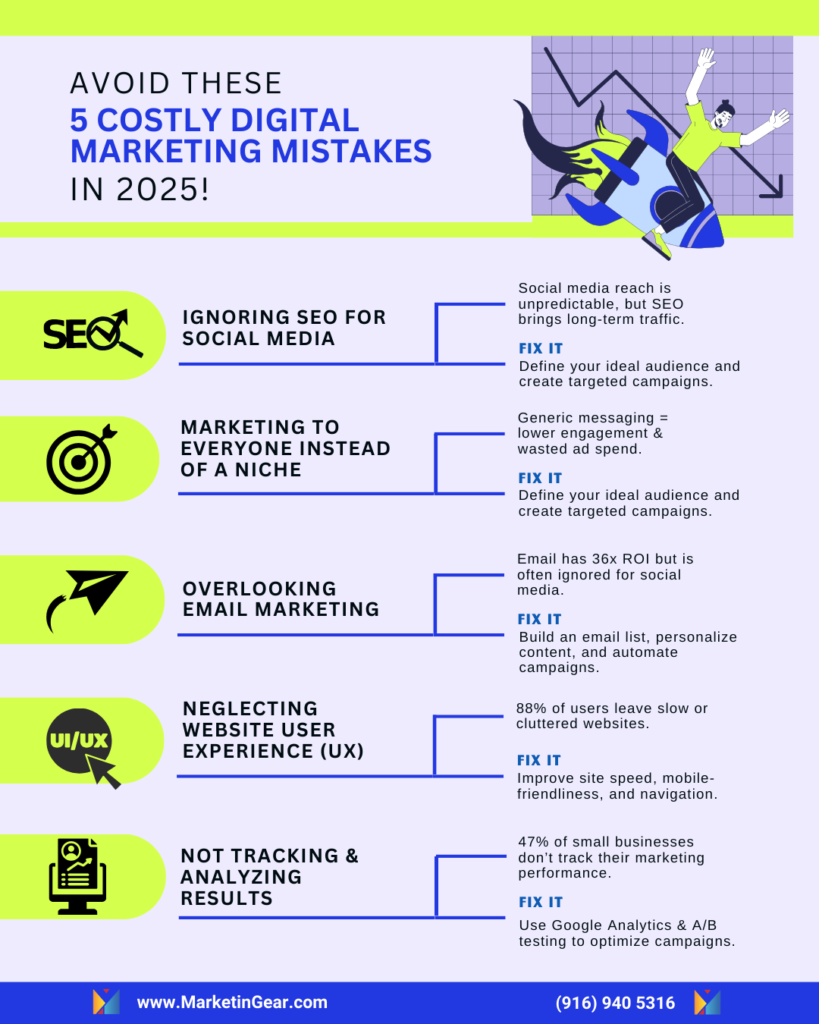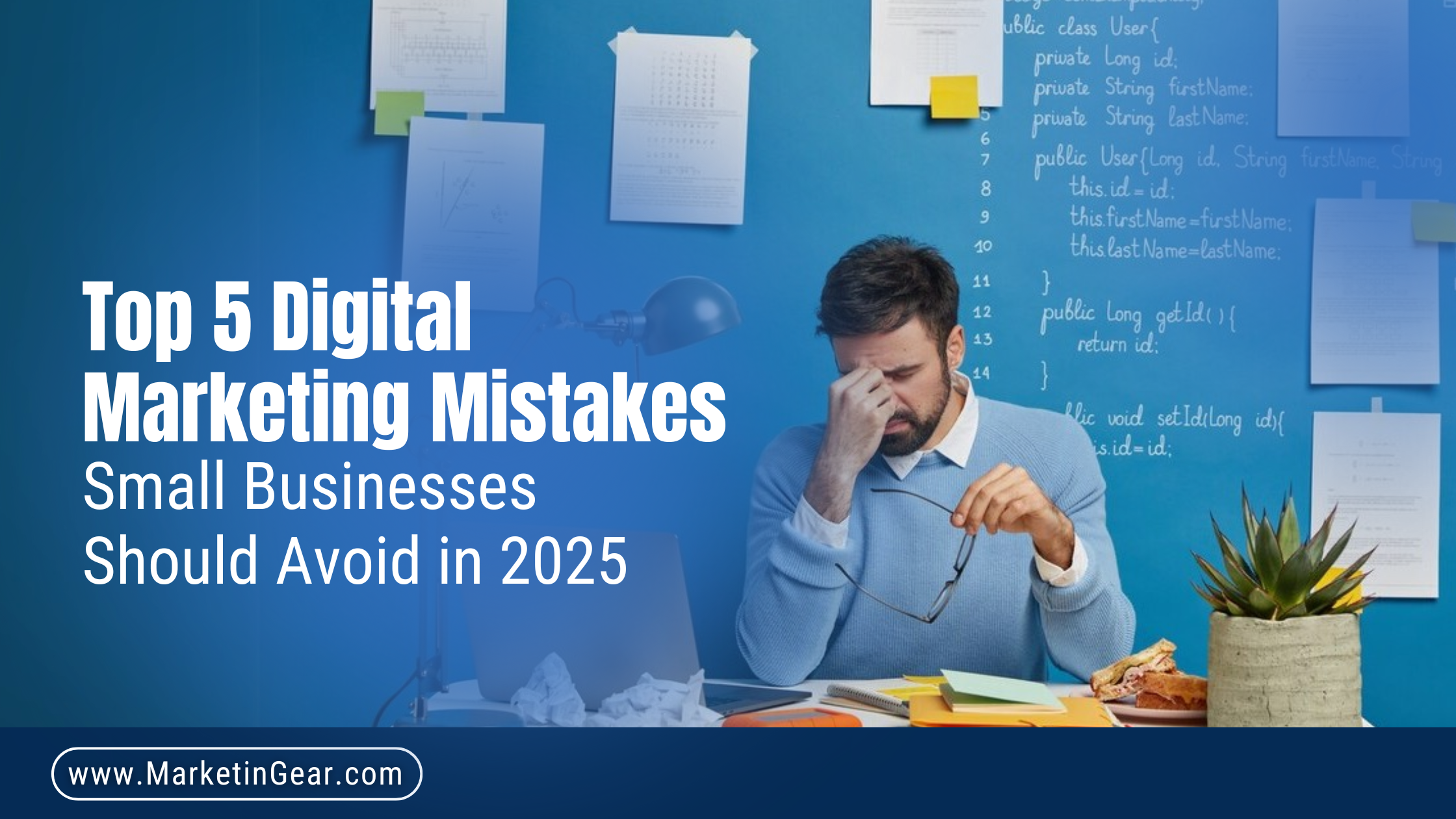Introduction
Running a small business is like juggling—there’s always something demanding your attention. But when it comes to digital marketing, dropping the ball can cost you big time. The online world evolves rapidly, and what worked last year might not cut it in 2025. Competition is fierce, and small businesses need a sharp digital strategy to stand out. Without the right approach, you could be wasting time, money, and effort on ineffective tactics. Understanding the latest trends and best practices is crucial for success. To help you navigate the digital landscape, we’re breaking down the five biggest digital marketing mistakes small businesses should avoid—and how to fix them.

1. Ignoring SEO in Favor of Social Media
The Mistake: Many small business owners think social media is the ultimate marketing tool. While platforms like Instagram, TikTok, and Facebook are valuable, relying solely on them and neglecting Search Engine Optimization (SEO) is a major pitfall. Social media algorithms change frequently, making it hard to maintain consistent reach. Additionally, organic social media traffic has a shorter lifespan compared to search engine rankings. Without SEO, small businesses miss out on a steady stream of potential customers actively searching for their services. Furthermore, social media engagement often fluctuates, and visibility depends on ever-changing platform rules. SEO, on the other hand, provides sustainable traffic, allowing businesses to build authority and attract leads over time.
Why It’s a Problem: Social media trends change quickly, and algorithm updates can drastically cut your reach overnight. Paid ads on social media can also become expensive, with unpredictable returns. Meanwhile, SEO offers long-term organic traffic, credibility, and leads from search engines like Google. A well-optimized website and content strategy ensure that potential customers find you consistently, rather than relying on fleeting social media trends.
How to Fix It:
- Invest in keyword research and optimize your website for search engines. Focus on long-tail keywords to attract highly targeted traffic. Regularly update content to align with search trends and user intent.
- Create high-quality, evergreen blog content targeting your audience’s pain points. Focus on providing actionable insights that solve real problems. Keep content updated to maintain relevance and value over time.
- Improve your website’s technical SEO, including loading speed and mobile-friendliness. Ensure proper site structure with clean URLs and intuitive navigation. Use schema markup to enhance search engine visibility and improve click-through rates.
- Build backlinks by collaborating with industry partners. Guest post on reputable blogs to establish authority and increase referral traffic. Engage in digital PR by getting featured in industry news and directories.
2. Targeting Everyone Instead of a Niche Audience
The Mistake: Small businesses often try to appeal to everyone, leading to vague messaging and wasted marketing budgets. Without a well-defined audience, marketing efforts lack focus, making it hard to create meaningful connections. This not only results in low engagement but also weakens brand identity, making it difficult to stand out in a crowded marketplace.
Why It’s a Problem: If you market to everyone, you resonate with no one. Generic messaging fails to connect, and your business struggles to stand out. Customers want to feel understood, and broad messaging often misses their specific needs. A targeted approach helps build stronger relationships, trust, and loyalty with your ideal audience.
How to Fix It:
- Define your Ideal Customer Profile (ICP) by analyzing demographics, behaviors, and pain points. Identify their biggest challenges and motivations to tailor your messaging. Use surveys and customer feedback to refine your ICP over time.
- Craft content and ads that speak directly to your niche audience. Highlight their pain points and present solutions that resonate. Use storytelling to create emotional connections and build brand loyalty.
- Use data-driven marketing to segment your audience and personalize campaigns. Leverage AI-driven insights to predict customer behaviors and tailor messaging accordingly. Continuously test and refine your approach based on performance data for optimal results.
3. Overlooking the Power of Email Marketing
The Mistake: Many small businesses think email marketing is outdated and focus entirely on social media and paid ads. They assume customers ignore emails, but in reality, well-crafted emails have high engagement rates. Overlooking email marketing means missing out on one of the most cost-effective ways to nurture leads and drive repeat business. Emails provide a direct line to customers, ensuring your message isn’t lost in a crowded social feed. Plus, automation allows for timely follow-ups that keep your brand top-of-mind.
Why It’s a Problem: Unlike social media, where algorithms control visibility, emails land directly in a prospect’s inbox. Ignoring this powerful channel means missing out on nurturing leads and boosting conversions. Email marketing allows for direct, personalized communication that strengthens customer relationships. Additionally, email campaigns provide measurable data, helping businesses refine their messaging and improve engagement rates over time.
How to Fix It:
- Build an email list with lead magnets (e.g., free guides, discounts, exclusive content). Run contests or giveaways to encourage sign-ups. Promote your newsletter through social media and blog content to expand your reach.
- Segment your email list and personalize content based on user behavior. Send tailored recommendations based on past interactions. Use dynamic content to make emails more engaging and relevant.
- Use automated email sequences to nurture leads and convert prospects into customers. Implement personalized drip campaigns based on user actions. Track engagement metrics to refine messaging and improve conversion rates.
4. Neglecting Website User Experience (UX)
The Mistake: Small businesses often focus on flashy designs but overlook functionality, leading to slow load times, cluttered navigation, and poor mobile optimization. A visually stunning website loses its value if users struggle to navigate or leave due to frustration. Neglecting usability not only harms search rankings but also reduces engagement and conversions. Accessibility issues can further alienate a portion of your audience, limiting potential growth. Prioritizing an intuitive user experience ensures higher customer satisfaction, retention, and overall business success.
Why It’s a Problem: A slow or confusing website drives visitors away, increasing bounce rates and lowering conversions. Google also prioritizes user-friendly websites in search rankings. Poor UX frustrates potential customers, reducing trust and credibility. A seamless website experience keeps visitors engaged and encourages them to take action, whether it’s making a purchase or contacting your business.
How to Fix It:
- Optimize website speed by compressing images and minimizing code. Enable browser caching to reduce load times for returning visitors. Use a Content Delivery Network (CDN) to distribute content efficiently across multiple servers.
- Ensure mobile responsiveness—more than 60% of web traffic comes from mobile devices. Optimize touch elements for easy navigation on smaller screens. Test your website across multiple devices to ensure a seamless user experience.
- Simplify navigation and make key information easy to find. Use clear menus and logical page structures to improve user experience. Implement a search function to help visitors locate content quickly.
- Add clear CTAs (Call-to-Actions) to guide visitors toward conversions. Use action-driven language like “Get Started Today” or “Claim Your Free Trial.” Place CTAs strategically in high-visibility areas such as the homepage, blog posts, and product pages.
5. Failing to Track and Analyze Marketing Efforts
The Mistake: Many small businesses run ads, post on social media, and send emails without analyzing what’s working and what’s not. They assume that simply being active online will drive results, but without proper tracking, they’re flying blind. This leads to wasted budgets, ineffective campaigns, and missed opportunities for growth. Without data, businesses struggle to identify what resonates with their audience. Additionally, failing to track performance can result in repeated mistakes and stagnant growth.
Why It’s a Problem: Without tracking data, businesses waste money on ineffective campaigns and miss opportunities for growth. Blindly spending on ads and marketing efforts without insights leads to inefficient budget allocation. Tracking key metrics allows businesses to refine their approach, maximize ROI, and stay ahead of competitors. Data-driven decisions enable better targeting, improved customer engagement, and higher conversion rates. Without performance analysis, businesses risk stagnation, falling behind competitors who leverage insights for continuous improvement.
How to Fix It:
- Use free tools like Google Analytics, Google Search Console, and social media insights to track performance. Leverage heatmaps to understand user behavior on your site. Set up goal tracking to measure conversions and optimize strategies accordingly.
- Set up conversion tracking to measure ROI from ads and campaigns. Use UTM parameters to track ad performance and identify high-converting channels. Regularly review analytics reports to refine ad strategies and maximize returns.
- Continuously test and optimize strategies based on data. A/B test different ad creatives, email subject lines, and website layouts to identify what resonates best with your audience. Adjust your approach based on real-time insights to maximize engagement and conversions.
Conclusion
Digital marketing in 2025 is all about strategy, adaptability, and focusing on what works. Avoiding these five common mistakes will help small businesses grow online, attract the right customers, and maximize their marketing efforts. Staying ahead requires a proactive approach, continuous learning, and leveraging data-driven decisions. Small businesses that embrace these principles will gain a competitive edge and see sustained growth in the digital space.Need expert help? MarketinGear specializes in all-in-one digital marketing solutions tailored for small businesses. Schedule a free consultation today and let’s build a smarter marketing strategy together!




